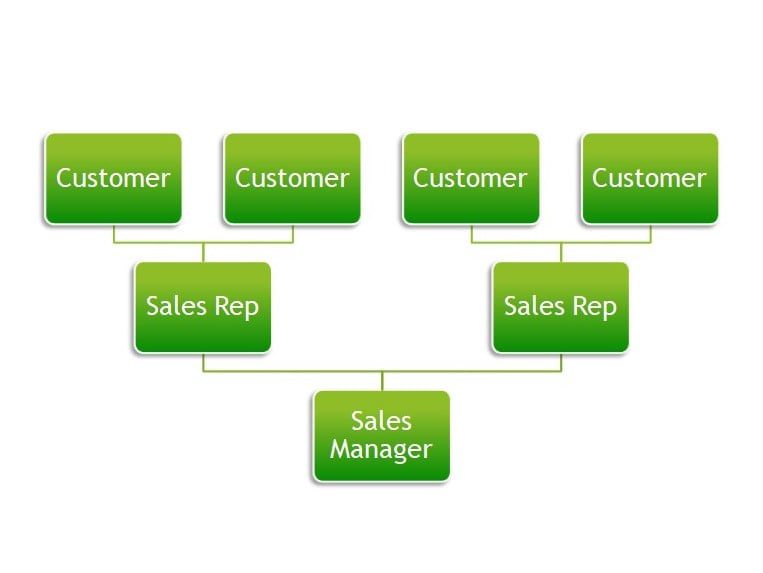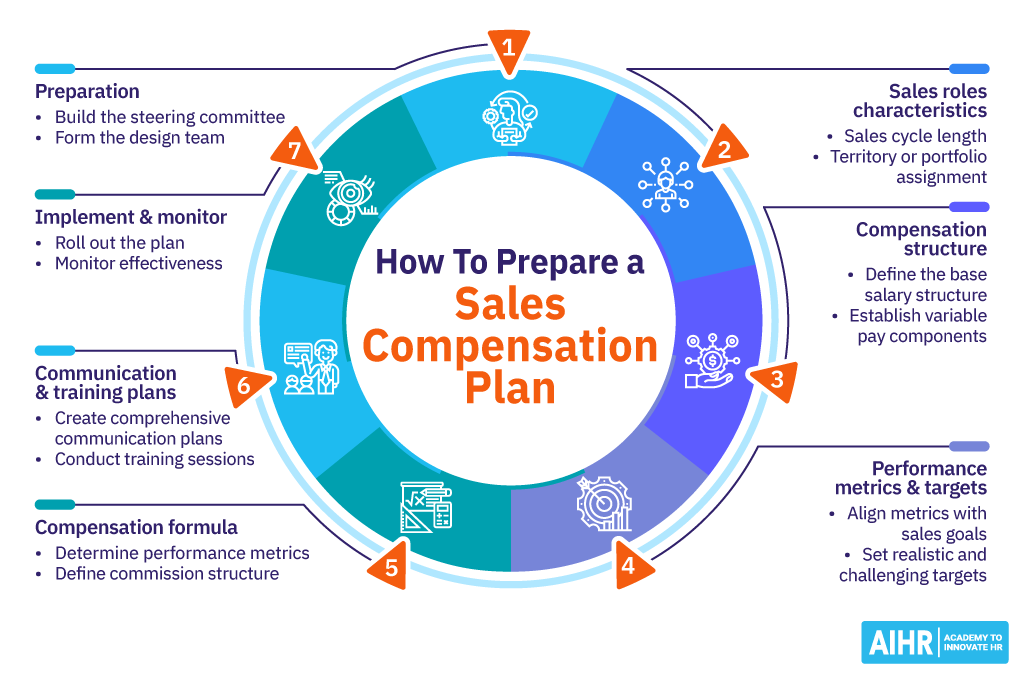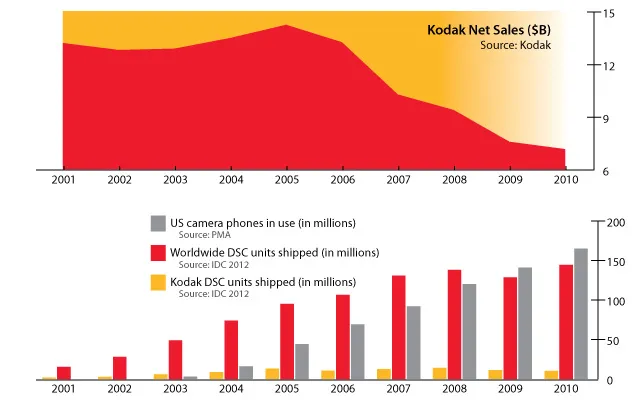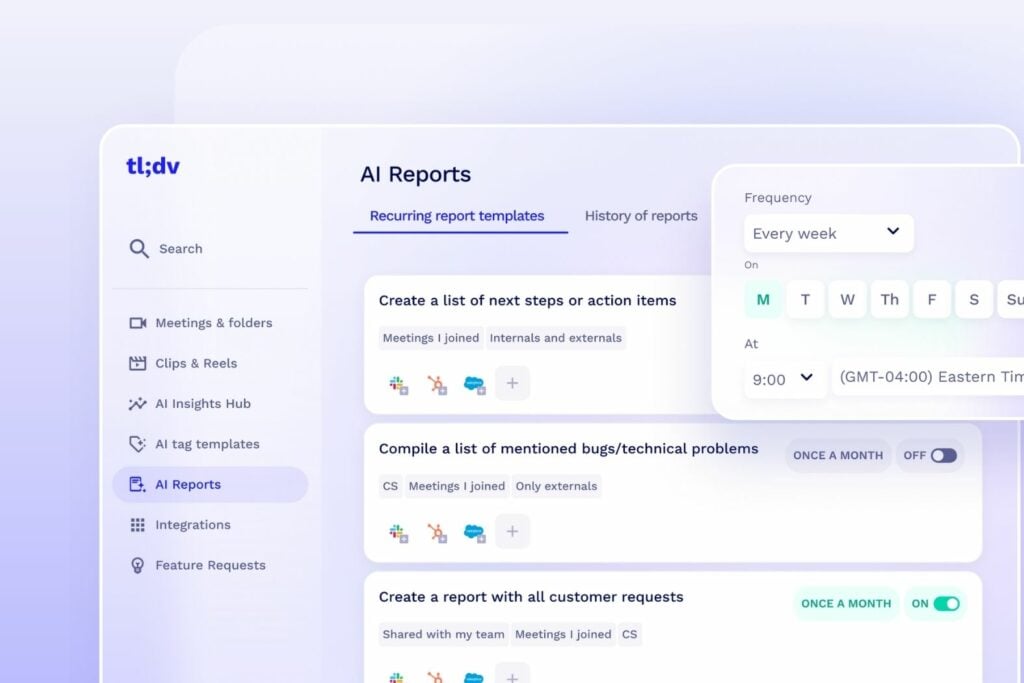Das Vertriebsmanagement ist ein unglaublich wichtiger Teil des gesamten Vertriebsprozesses, und während die C-Ebene das Team ist, das für das Vorantreiben des Gesamtprodukts und des Geschäfts verantwortlich ist, neigen das Vertriebsmanagement und die Vertriebsleiter dazu, sich zwischen beiden Welten zu bewegen.
Sie sind der Dreh- und Angelpunkt für den Erfolg und die Rendite, haben aber auch nur minimale Kontrolle über das eigentliche "Innenleben" des Verkaufsgesprächs. In dieser Rolle geht es um Schulung, Modellierung und bewährte Verfahren, aber auch darum, sicherzustellen, dass die Moral aufrechterhalten wird und dass sie ihr Team effektiv führen.
Und obwohl die Art eines Vertriebsteams, einer Abteilung oder einer Einzelperson je nach Branche, Unternehmensgröße, Taktik und sogar geografischer Lage variieren kann, ist gutes Vertriebsmanagement universell und kann als eine Reihe von Fähigkeiten, Grundsätzen und Kenntnissen erlernt werden.
Was ist gutes Verkaufsmanagement?
Stellen Sie diese Frage verschiedenen Personen innerhalb desselben Unternehmens, und Sie werden wahrscheinlich unterschiedliche Antworten erhalten. Ein Vertriebsmitarbeiter spricht vielleicht von Schulungen, Einfühlungsvermögen und allgemeiner Beratung, ein CFO von einer Verdreifachung der Kapitalrendite bei Personal, technischem Aufwand und Ressourcen.
Die Definition von "gut" ist zwar subjektiv, aber es ist sehr leicht zu erkennen, wenn das Vertriebsmanagement nicht effektiv funktioniert.
"Gute Manager führen aus und motivieren. Nicht alle Führungskräfte müssen Manager sein, aber alle Manager müssen gute Führungskräfte sein. Management ist eine Kunst; Führung ist eine Fähigkeit, die bei der Ausführung von Aufträgen durch Untergebene vermittelt und durchgesetzt werden muss.
Henrietta Newton Martin- Autorin Strategisches Personalmanagement - Eine Fibel Tweet
In einer Studie von Dr. Adam Ran von der Ohio University untersuchten die Wissenschaftler, wie viele Vertriebsteams ihre Gesamtziele erreichten, aber auch, wie sich dies auf die individuelle Leistung der Mitarbeiter auswirkte.
Das Gesamtergebnis war, dass viele Teams ihr gesamtes Ziel auf der Grundlage der Bemühungen von nur wenigen Vertriebsmitarbeitern erreichten.
Die auffälligste Statistik war, dass der durchschnittliche Vertriebsleiter seine Quote zu 99 % erfüllte, aber nur 48 % der Vertreter ihre Ziele tatsächlich erreichten. Das bedeutet, dass das Verkaufsteam zwar insgesamt gut abschnitt, aber auf individueller Ebene ist dies nicht der Fall.
Ein gutes Vertriebsmanagement sollte dafür sorgen, dass die Bedürfnisse des Unternehmens erfüllt werden, indem die Vertreter, die zusätzliche Unterstützung benötigen, unterstützt werden, anstatt Druck auf einzelne Mitarbeiter auszuüben, die hervorragende Leistungen erbringen. Mit diesem Ansatz können Sie sicherstellen, dass Sie nicht auf verlorenem Posten stehen, wenn einer Ihrer leistungsstärksten Vertriebsmitarbeiter das Unternehmen oder das Team verlässt, um die Verkaufsziele zu erreichen. Wenn alle Mitarbeiter die Zielvorgaben durchgängig erreichen, führt dies zu einem insgesamt stabileren Team.

Was ist ein Verkaufsleiter?
Ein Verkaufsleiter ist eine Person, deren Aufgabe es ist, die täglichen Verkaufsvorgänge zu überwachen und gleichzeitig mit dem Verkaufsleiter oder den höheren Führungskräften in Verbindung zu stehen.
Ein Verkaufsleiter ist in der Regel die Person, die Ziele, Team- und Einzelziele festlegt und die Einstellung und Schulung überwacht.
Ein erfolgreicher Vertriebsleiter zeichnet sich dadurch aus, dass er in der Regel ein guter Kommunikator ist, wahrscheinlich selbst ein erfolgreicher Vertriebsmitarbeiter war und in der Lage ist, ein Team in guten und schlechten Zeiten zu führen. Personalvermittler für Vertriebsleiter können dabei helfen, qualifizierte Bewerber für diese Position zu finden, die über die erforderliche Erfahrung und Führungsqualitäten verfügen.
Was ist ein Verkaufsdirektor?
Ein Vertriebsleiter ist eine Führungskraft auf höherer Ebene, die für die Vertriebsabteilung verantwortlich ist. Er ist in der Regel dem CEO und anderen Führungskräften unterstellt und arbeitet direkt mit dem oder den Vertriebsleiter(n) zusammen, wobei er eine eher strategische als operative Rolle spielt.
Im Gegensatz zu einem Vertriebsleiter, der die täglichen Vertriebsaktivitäten und die Leistung des Teams direkt überwacht, ist ein Vertriebsleiter auf einer strategischeren Ebene tätig und kümmert sich häufig um Großkunden, verhandelt über große Verträge und baut Beziehungen zu wichtigen Kunden auf. Er spielt auch eine entscheidende Rolle bei der Gestaltung der Verkaufsstrategien, der Marktpositionierung und der Preispolitik des Unternehmens.
Sie werden auch derjenige sein, der mehr mit anderen Abteilungsleitern wie den Direktoren für Marketing, Entwicklung und Finanzen in Verbindung steht, was einen stärker organisatorischen und strategischen Ansatz erfordert.
Wer profitiert von einem guten
Vertriebsmanagement?
Die kurze Antwort lautet: alle!
Wenn das Vertriebsmanagement gut funktioniert, sind die Vertriebsmitarbeiter glücklich und zufrieden, und das gilt auch für die Vertriebsleiter.
Das bedeutet in der Regel, dass die Kunden zufrieden sind und die Qualität der Verkaufsgespräche stimmt. Hier gibt es das richtige Gleichgewicht zwischen "Verkauf" und Kundenzufriedenheit.
Hinzu kommen die allgemeinen Vorteile eines guten
es.
Andere Abteilungen können wachsen und gedeihen, weil sie mit Geld und Ideen versorgt werden.
Und schließlich sind die Führungsebene und die Stakeholder zufrieden. Ein Unternehmen mit einer gut geführten Vertriebsabteilung ist in der Regel auch ein rentables Unternehmen. Der Vertrieb ist der Schlüssel zu fast jedem Element von Wachstum und Erfolg in einem Unternehmen.
Wir müssen dafür sorgen, dass viele Verkäufe stattfinden, und zwar zum richtigen Preis, mit dem richtigen Team und mit der richtigen Wachstumsrate. Das ist ein Rezept für den Erfolg!
Strategisches Vertriebsmanagement
Die Strategie des Vertriebsmanagements ist das Herzstück des Ganzen. Laut Definition ist Strategie die Planung, Umsetzung und Kontrolle von Verkäufen und Initiativen, um sie mit den allgemeinen Unternehmenszielen in Einklang zu bringen. Es ist der Prozess, bei dem jede Entscheidung - von der Wortwahl über den Zeitpunkt der Anrufe bis hin zur Art der Produktpräsentation - so getroffen wird, dass sie maximale Wirkung, Rendite und Effizienz erzielt.
Die Vertriebslandschaft entwickelt sich ständig weiter, geprägt von technologischen Fortschritten, veränderten Verbraucherpräferenzen und der Dynamik des Wettbewerbs.
Ein effektives Vertriebsmanagement muss daher nicht nur diese Veränderungen antizipieren, sondern auch schnell und strategisch reagieren, um einen Wettbewerbsvorteil zu erhalten.
Diese Rolle beinhaltet eine kontinuierliche Feedbackschleife, in der Vertriebsdaten und Markteinblicke in strategische Anpassungen einfließen, was das Vertriebsmanagement zu einem kritischen Reflexionspunkt innerhalb des Unternehmens-Ökosystems macht.
Es ist diese strategische Fähigkeit, Daten zu interpretieren und danach zu handeln, gepaart mit der Fähigkeit, unterschiedliche Teams zu motivieren und zu führen, die die erfolgreichsten Vertriebsmanager und Vertriebsmanagementteams auszeichnet.
Festlegung von Vergütung und Anreizen
Einer der Hauptgründe, warum sich jemand für den Vertrieb entscheidet, ist die Tatsache, dass er im Vergleich zu vielen anderen Tätigkeiten und Jobs finanziell lohnend sein kann. Auch wenn die Vergütung und die Provisionen je nach Unternehmen und Branche variieren können, ist es wahrscheinlich, dass jeder Vertriebsleiter und -direktor eine Art von Provisionsstruktur formulieren muss, die sowohl Anreize und Belohnungen für sein Vertriebsteam bietet als auch das Endergebnis für die Führungsebene und die Interessengruppen nicht schmälert.
Wenn die Vertriebsleitung sich mit Vergütungen und Anreizen befasst, muss sie sorgfältig abwägen, ob sie ihr Team motivieren und mit der finanziellen Gesamtlage des Unternehmens in Einklang bringen will. Wirksame Vergütungsstrategien bestimmen nicht nur Dinge wie die Vertriebsleistung im eigenen Haus und aufremote und die Wahl unterschiedlicher Methoden für dieVertriebsleistung, sondern stärken auch die Werte und Ziele des Unternehmens. Vertriebsleiter sollten verschiedene Vergütungsmodelle in Betracht ziehen, z. B. Grundgehalt plus Provision, gestaffelte Provisionsstrukturen, Boni für die Erreichung von Zielen und nicht-monetäre Belohnungen, die die Moral und Loyalität fördern können.
Um diese Anreize zu optimieren, müssen klare, erreichbare und messbare Ziele festgelegt werden, die von allen Teammitgliedern verstanden werden. Incentive-Programme sollten transparent sein und regelmäßig überprüft werden, um sicherzustellen, dass sie auch weiterhin den Anforderungen der Vertriebsmitarbeiter und des Unternehmens entsprechen. Dazu gehört die Analyse von Leistungsdaten, das Einholen von Feedback aus dem Team und die ständige Information über die besten Praktiken der Branche.
Ein gut durchdachter Incentive-Plan kann als Rekrutierungs- und Bindungsinstrument dienen, um Top-Talente für Ihr Unternehmen zu gewinnen und die Fluktuation zu verringern. Indem sie die Vergütung direkt an die Leistung koppeln, können Vertriebsleiter eine energiegeladene, ergebnisorientierte Kultur schaffen, die immer wieder zu neuen Höchstleistungen anspornt.
Unten sehen Sie eine Grafik, die einen detaillierten Prozess zur Erstellung eines Vergütungsplans für den Vertrieb zeigt.


Sie verfolgen Ihre Vertriebskennzahlen, um sicherzustellen, dass Sie gute Geschäftsentscheidungen treffen. Verbessern Sie Ihre Vertriebskennzahlen mit diesen Tipps...
Ziele und Quoten für das Verkaufsteam festlegen
Eine weitere Messgröße, die von der Vertriebsleitung sehr genau betrachtet werden muss und die oft die meisten Reibungen auf beiden Seiten der Vertriebsleitung verursacht, sind die Verkaufsquoten.
Die Verwendung von Methoden zur Absatzprognose und von gesammelten Daten kann dabei helfen, diese auf logische und endgültige Weise zu erstellen, aber es ist auch eine Kunst, sie zu erstellen und zu liefern.
Aber es ist ganz einfach.
Wenn Sie Ihre Ziele zu hoch ansetzen, demoralisieren Sie Ihr Verkaufsteam und führen das obere Management in die Irre.
Wenn Sie Ihre Ziele zu niedrig ansetzen, kann es passieren, dass Ihr Vertriebsteam auf der Stelle tritt und die Unternehmensleitung Ihre Prognosefähigkeit in Frage stellt.
Bei der Festlegung von Quoten und Zielen kommt es darauf an, das Ziel und dann das Stretch-Ziel zu finden. Sie wollen auf früheren Verkaufserfolgen aufbauen, Sie müssen die saisonalen Schwankungen in den einzelnen Quartalen berücksichtigen und auch, was in der Welt passiert, aber Sie müssen auch realistisch bleiben.
Und ähnlich wie bei der Festlegung persönlicher Ziele kann der SMART-Rahmen ein wertvolles Instrument im Arsenal des Vertriebsleiters sein, wenn es um Quoten geht.
- Spezifisch: Die Ziele sollten klar und fokussiert sein und keine Unklarheiten über die Erwartungen zulassen.
- Messbar: Es muss einen klaren Maßstab geben, an dem sich Erfolg oder Misserfolg messen lassen.
- Erreichbar: Die Ziele sind zwar anspruchsvoll, müssen aber erreichbar sein, um die Verkaufsmotivation aufrechtzuerhalten.
- Relevant: Jedes Ziel sollte mit den übergeordneten Unternehmenszielen übereinstimmen, um sicherzustellen, dass jede Maßnahme direkt zu den strategischen Zielen des Unternehmens beiträgt.
- Zeitgebunden: Ziele sollten einen klaren Zeitrahmen haben, der Dringlichkeit und einen Zeitrahmen für die Bewertung schafft.
Außerdem sollten die Ziele idealerweise auf der Grundlage der einzelnen Teammitglieder, ihrer Fähigkeiten und Erfahrungen angepasst werden. Personalisierte Ziele gehen nicht nur auf die Stärken der einzelnen Vertriebsmitarbeiter ein, sondern auch auf ihre Entwicklungsbereiche, wodurch die Ziele relevanter und motivierender werden.
Auch die Ziele sollten nicht in Stein gemeißelt sein. Auch wenn die obere Führungsebene dies anders sieht, ist es wichtig, flexibel und realistisch zu sein, wenn es darum geht, Anpassungen an die aktuellen Bedingungen vorzunehmen. Es sollte nicht heißen: "Setzen und Vergessen". Ein Vertriebsleiter sollte sich ständig mit den Teammitgliedern mit Kundenkontakt austauschen und auch die Geschäftsleitung auf dem Laufenden halten. Ein anpassungsfähiger Ansatz trägt dazu bei, die Motivation des Teams aufrechtzuerhalten und stellt sicher, dass die Verkaufsstrategien relevant bleiben und sowohl die individuelle als auch die organisatorische Verkaufsleistung maximiert wird.
Umsatzprognose und Zukunftsplanung
Um die Zahlen für die Verkaufsquoten zu erreichen, ist die Verkaufsleitung auch für die Umsatzprognose für das Team verantwortlich.
Hier beginnen die Zahlen, sich mehr um die Wünsche des oberen Managements und der Stakeholder zu drehen als um die täglichen Verkaufszahlen.
Die Vertriebsleiter sollten die Zahlen und die Umsatzentwicklung aus der Vogelperspektive betrachten können und Zugang zu Daten und Software haben, die eine Planung auf der Grundlage von Trends und Marktbedingungen ermöglichen.
Dies ist auch der Bereich, in dem sie für ihr Verkaufsteam ein Vorbild sein müssen. Ein solider Vertriebsleiter weiß, wie wichtig es ist, ein Gleichgewicht zwischen den Bedürfnissen des Unternehmens und den realistischen Erwartungen des Vertriebsteams herzustellen. Nichts ist demotivierender als ein Vertriebsleiter, der mit der Führungsebene unrealistische Ziele vereinbart und dann sein Team dazu drängt, das Unerreichbare zu erreichen.
Ebenso wichtig ist es, Wachstumsprognosen zu erstellen, damit die Unternehmensleitung eine Strategie für die Investitionen und das Wachstum des Unternehmens entwickeln kann. Wenn man sich zu sehr auf "Nummer sicher" geht, kann dies zur Stagnation des Unternehmens führen, zu verpassten Chancen und zu der Gefahr, dass Wettbewerber die Lücken nutzen, die ein Unternehmen hinterlässt.
Beide Seiten sind bei zwei verschiedenen Unternehmen und ihren Untergangsgeschichten offensichtlich.
Ein Unternehmen, das zum Teil aufgrund unrealistischer Ziele zusammenbrach, war Wells Fargo.
Mitarbeiter, die unter dem Druck standen, diese unrealistischen Ziele zu erreichen, eröffneten ohne Zustimmung der Kunden Millionen von nicht genehmigten Konten. Dies führte nicht nur zu massiven Geldstrafen und Rufschädigung, sondern verdeutlichte auch die schwerwiegenden Folgen zu hoch gesteckter Verkaufsziele.
Der Skandal führte zu einem Vergleich in Höhe von 3 Milliarden Dollar, um straf- und zivilrechtliche Anklagen im Zusammenhang mit diesen Praktiken beizulegen, und unterstreicht die Bedeutung einer ethischen Festlegung von Verkaufszielen und die Risiken, die entstehen, wenn man kurzfristigen Gewinnen Vorrang vor nachhaltigen Geschäftspraktiken einräumt. Dies ist ein klares Beispiel dafür, wo das Vertriebsmanagement auf spektakuläre Weise versagt hat.

Auf der anderen Seite führten Selbstgefälligkeit und Nachlässigkeit zum Untergang von Kodak. Dies hatte zwar nicht direkt mit zu niedrigen Verkaufszielen zu tun, war aber eher darauf zurückzuführen, dass man sich stärker auf die Verkaufsziele im Bereich des traditionellen Films konzentrierte, um den aktuellen Marktanteil nicht zu "kannibalisieren". Dies führte dazu, dass man sich nur in sehr geringem Maße auf digitale Verkäufe konzentrierte, während andere Wettbewerber wie Nikon und Canon sich darauf konzentrierten.
Das Ergebnis war, dass Kodak 2012 schließlich Konkurs anmeldete. In diesem Szenario hätte die Vertriebsleitung diesen Wandel in der Branche wahrscheinlich an das obere Management weitergegeben, doch die Führungskräfte ignorierten dies und hielten an ihrer Gesamtstrategie der traditionellen Fotografie fest.
DieVertriebsleitung war nicht in der Lage, die harten Daten und das Marktgeschwätz zu nutzen, die ihre Teams benötigt hätten, um die Geschicke des Unternehmens zu lenken, und obwohl die Schuld nicht bei ihnen liegt, stellt sich doch die Frage, ob sie mit ihren Erkenntnissen hart genug gegen die Unternehmensleitung vorgegangen sind oder nur auf die aktuellen Quartalszahlen geschaut haben. Die traurige Ironie ihres Versagens besteht darin, dass ein Kodak-Mitarbeiter die Digitalkamera im Jahr 1975 erfunden hat.
Wenn das Vertriebsmanagement jedoch das richtige Gleichgewicht findet, kann es die Geschicke eines Unternehmens grundlegend verändern. Einige der bekanntesten Marken der Welt begannen ihr Leben als ganz andere Unternehmen.
Sanrio - Ursprünglich wurde Sanrio 1960 als Seidenhersteller gegründet, der auch Gedichte veröffentlichte. Das Unternehmen nutzte jedoch Marktdaten, um sich auf den Geschenkemarkt zu verlagern und konzentrierte sich dabei auf die Herstellung von Artikeln mit niedlichen Figuren. Diese Neuausrichtung war sehr erfolgreich und gipfelte in der Erschaffung von Hello Kitty im Jahr 1974, die zu einem weltweiten kulturellen Phänomen wurde. Sanrio nutzte seine Verkaufsdaten und Markttrends, um sich auf verschiedene andere Figuren und eine umfangreiche Produktpalette von Schulbedarf bis hin zu Modeaccessoires auszudehnen. Heute ist das Unternehmen im Jahr 2024 knapp 5 Milliarden Dollar wert.
Nintendo - Nintendo ist ein Synonym für Spiele und Innovation, aber eigentlich begann das Unternehmen 1889 als Spielkartenhersteller. Im Laufe der Jahre nutzte Nintendo Marktanalysen und Prognosen, um sich zu einem Spielzeughersteller und schließlich zu einem der führenden Unternehmen in der elektronischen Spieleindustrie zu entwickeln, insbesondere nachdem es in den 1970er Jahren das Potenzial der elektronischen Unterhaltung erkannt hatte. Das Ergebnis ist ein Unternehmen, das im Jahr 2024 mit mehr als 65 Milliarden Dollar bewertet wird.
IBM - Zu den bescheidenen Anfängen dieses Technologieunternehmens gehörte der Verkauf von Fleisch- und Käseschneidern! Die Computing-Tabulating-Recording Company wurde 1911 als Einzelunternehmen gegründet. Durch strategische Veränderungen, die sich an den Marktbedürfnissen und technologischen Fortschritten orientierten, verlagerte die später in IBM umbenannte Firma ihren Schwerpunkt auf die Computertechnologie, insbesondere auf Hardware und später auf Software und Dienstleistungen, und wurde so zu einem dominierenden Akteur im Technologiesektor. Heute wird der Marktwert des Unternehmens auf rund 170 Milliarden Dollar geschätzt.
Alle drei Erfolgsgeschichten zeigen, wie eine Brücke zwischen dem Vertrieb und dem oberen Management die gesamte Entwicklung eines Unternehmens oder einer Organisation verändern kann. Die Vertriebsleitung muss flink, beweglich und mutig sein, nicht nur, wenn es darum geht, Risiken einzugehen, sondern auch, wenn es darum geht, ihre Vorgesetzten darüber zu informieren, wie sie das Unternehmen am besten voranbringen können.
Onboarding und kontinuierliche Schulung
Einer der einflussreichsten Bereiche für das Vertriebsmanagement ist die Einstellung und Entwicklung des Teams und der Mitarbeiter. Ein solides Vertriebsmanagement bedeutet, dass man in der Lage ist, Teams aufzubauen, die bereits über Vertriebsfähigkeiten verfügen, aber auch bereit sind, langfristig Zeit, Mühe und Investitionen in die Entwicklung dieser Fähigkeiten zu stecken.
Eine der wirkungsvollsten Methoden, um neue Mitarbeiter an Bord zu holen, besteht darin, ihnen eine sich ständig weiterentwickelnde und interaktive playbook zur Verfügung zu stellen, zusammen mit einer separaten customer success playbook. Anhand dieser Dokumente kann jeder neue Mitarbeiter leicht nachlesen, was die besten Praktiken sind, hat praktikable Beispiele und auch einige schnelle Antworten auf einfache Fragen.
Die Vertriebsleitung muss dafür sorgen, dass sie ein Gleichgewicht zwischen der Ansprechbarkeit ihrer Teams und dem autoritären Charakter des Managements findet. Sie müssen in der Lage sein, ihre Vertriebsteams zu entwickeln und in gut funktionierende, kooperative Teams zu verwandeln, die sich auf ein gemeinsames Ziel und eine gemeinsame Vision konzentrieren, aber auch sicherstellen, dass sie bei Bedarf harte Entscheidungen treffen können.
Nachfolgend finden Sie ein Video, in dem es um die kontinuierliche Verbesserung oder "Kaizen" geht, die sowohl für den Vertriebsmitarbeiter als auch für die Vertriebsleitung von Bedeutung ist. Dieser Ansatz ist eine sehr gute Grundlage, egal ob Sie gerade erst mit dem Vertriebsmanagement begonnen haben oder schon viele Jahre Erfahrung haben.

Erschließen Sie den Verkaufserfolg mit einem Sales Playbook. Es ist Ihr strategischer Leitfaden für die Ausrichtung von Teams und die Verfeinerung von Methoden, um in der Vertriebsarena zu gewinnen.
Schlüsselelemente für den Erfolg: Disziplin und HR-Unterstützung
Es gibt eine Denkschule, die davon ausgeht, dass Disziplin im Verkauf und im Verkaufsmanagement mehr Einfluss hat als tatsächliche Verkaufsfähigkeiten und Talent. Anthony Iannarino, Autor bei TheSalesBlog, erklärt, dass Disziplin tatsächlich die wichtigste Fähigkeit im Verkauf ist.
Als Vertriebsleiter kann es schwierig sein, zu wissen, wann man Druck auf seine Teams ausüben und wann man sich zurückhalten sollte. Zu viel Nachsicht kann dazu führen, dass die Vertriebsteams Ihre Gutmütigkeit ausnutzen und die Vertriebsleitung als Sandsack für den Unmut der oberen Führungsebene herhalten muss. Zu viel harte Disziplin kann dazu führen, dass die Vertriebsleitung insgesamt als tyrannisch empfunden wird, was zu einer höheren Personalfluktuation führt.
Dies ist auch der Schlüssel zur allgemeinen Unternehmenskultur. Viele Vertriebsmitarbeiter haben das Unternehmen, für das sie arbeiten, geliebt, aber ihren Vorgesetzten gehasst. Wie viele Vertriebsmitarbeiter haben das Unternehmen, in dem sie gearbeitet haben, gehasst, hatten aber eine Vertriebsleitung, die es ihnen ermöglicht hat, die Arbeit zu bewältigen. Letztlich werden die Vertriebsmitarbeiter dort, wo die Vertriebsleitung gut ist, auch bleiben und sich unterstützt fühlen.
Ein weiterer Bereich, der für den Erfolg absolut ausschlaggebend ist, ist die Art und Weise, wie das Vertriebsmanagement mit unzureichenden Leistungen umgeht. Dies ist ein weiterer Balanceakt zwischen den Vertriebsmitarbeitern, dem oberen Management und anderen, aber mit zusätzlichen Nuancen innerhalb des Vertriebsteams selbst.
Vertriebsleiter sollten Disziplinarverfahren und Instrumente wie Leistungsverbesserungspläne eher positiv als negativ sehen. Im Allgemeinen herrscht die Meinung vor, dass es sich dabei lediglich um Mittel handelt, um leistungsschwache Mitarbeiter "loszuwerden". In Unternehmen mit einer schlechten Arbeitskultur oder gar Mobbing am Arbeitsplatz trifft dies zwar sicherlich zu, aber wenn sie effektiv eingesetzt werden, können sie tatsächlich ein hervorragendes Instrument für Verbesserungen und Entwicklung sein. Dies gilt nicht nur für die Mitarbeiter, sondern auch für die Vertriebsleitung selbst und für das gesamte Unternehmen.
Wenn Sie feststellen, dass diese häufiger als erwartet verwendet werden, kann dies auf tiefer liegende Probleme innerhalb der Organisation hinweisen. Hier sind einige Beispiele:
- Basieren die Leistungspläne hauptsächlich auf dem Nichterreichen von Zielen?
- Sind die Ziele zu hoch gesteckt?
- Werden die Schulungen in ausreichendem Maße und in einer Weise durchgeführt, dass sie umsetzbar sind?
- Wie sieht es mit den Daten aus, mit denen die Teams arbeiten?
- Richtet sich das Marketing an die falsche Kundenpersönlichkeit?
Dies sind alles Fragen, die sich anhand der Daten der Verkaufsleistung.
Wenn Sie viele negative Rückmeldungen von Vertriebsmitarbeitern erhalten und all diese Optionen geprüft haben, stellen Sie dann auch die richtigen Mitarbeiter ein? Was sind Ihre Einstellungskriterien? Gibt es Trends in bestimmten Abteilungen oder Regionen, die untersucht werden müssen?
Die Vertriebsleitung kann diese Informationen nutzen und mit Abteilungen wie der Personalabteilung zusammenarbeiten, um sicherzustellen, dass bei der Einstellung, dem Onboarding, der Schulung und Entwicklung und sogar bei Entlassungen kontinuierliche Verbesserungen erzielt werden.
Eine gute Kultur in einem Vertriebsumfeld, das Wachstum fördert und nach Leistung strebt, ohne (oder zumindest in relativ geringem Maße) bestimmte Probleme auf natürliche Weise in Schach zu halten. Außerdem kann der Verkauf ein emotional, psychologisch und sogar physisch hartes Umfeld sein. Die Vertriebsleitung ist ihrem Team gegenüber verpflichtet, sich um dessen Wohlergehen zu kümmern und sich für eine bessere Unternehmenskultur einzusetzen. Auch wenn die obere Führungsebene Ideen für Wellness-Initiativen und andere Möglichkeiten hat, die ausgelagert werden können, lassen sich viele gesundheitsbezogene Probleme durch ein gutes Vertriebsmanagement in den Griff bekommen.
Zusammenarbeit mit anderen Abteilungen
Ähnlich wie die direkte Zusammenarbeit mit dem oberen Management und der Personalabteilung ist die Zusammenarbeit des Vertriebs mit anderen Unternehmensbereichen eine der wichtigsten strategischen Aufgaben des Vertriebsmanagements. Vertriebsleiter und Direktoren sind die Aushängeschilder, die ihr Team vorantreiben, aber auch mit anderen Abteilungen in Verbindung stehen und ihnen Feedback geben.
Vertriebsmanagement und Marketing
Ein Paradebeispiel dafür und dafür, wie es ein Unternehmen voranbringen kann, ist die Synergie zwischen Vertrieb und Marketing. Beide verfolgen ähnliche Ziele, aber mit unterschiedlichen Methoden, Praktiken und manchmal auch Zielen. Der anhaltende Erfolg beider Abteilungen liegt jedoch in ihrer Zusammenarbeit.
Das Marketing sorgt für das Messaging und das Branding, um die Nachfrage zu wecken, während der Vertrieb direkt mit potenziellen Kunden in Kontakt tritt, um diese Nachfrage in Umsatz zu verwandeln. Durch die Abstimmung dieser Funktionen können beide Abteilungen effektiver die richtigen Zielgruppen mit konsistenten Botschaften ansprechen, was die Konversionsraten und den Gesamterfolg des Unternehmens erheblich steigern kann.
Wenn sie es richtig machen, bringt das Marketing die richtigen Kunden zum Vertrieb, die vorqualifiziert sind, so dass der Vertrieb eine persönliche Beziehung aufbauen kann, um sie ins Unternehmen zu holen.
Wenn es schief geht, bekommt das Marketing die falschen Kunden, die nicht qualifiziert sind, oder der Vertrieb lehnt vollkommen gute Interessenten aufgrund ihrer Wahrnehmung der Marketingabteilung ab.
Beide wollen gute Kunden, die ihr Produkt oder ihre Dienstleistung annehmen. Aber die Zusammenarbeit zwischen ihnen muss stimmen. Die Vertriebsleitung muss die Kommunikation zwischen den beiden aufrechterhalten und auch ehrliches, aber konstruktives Feedback zur Qualität der qualifizierten Leads und zur allgemeinen Markenwahrnehmung geben, die ihre Vertriebsmitarbeiter von potenziellen Kunden erhalten.
Vertriebsmanagement & Produkt
Eine weitere sehr wichtige Beziehung besteht zwischen Vertrieb und Produkt. Diese Beziehung ist von entscheidender Bedeutung, denn sie gewährleistet, dass die entwickelten Produkte und Dienstleistungen den Wünschen und Bedürfnissen des Marktes entsprechen.
Die Vertriebsteams stehen in direktem Kontakt mit den Kunden und erhalten wertvolle Einblicke in die Vorlieben und Probleme der Kunden. Indem der Vertrieb diese Informationen an die Produktentwicklung weitergibt, kann er die Entwicklung von Produkten unterstützen, die auf dem Markt erfolgreicher sind.
Die Vertriebsteams können in Echtzeit Feedback vom Markt geben, was für die Produktentwicklung von unschätzbarem Wert ist. Dieses Feedback kann zu Anpassungen der Produktmerkmale, des Designs oder der Funktionalität führen, die die Erwartungen und Anforderungen der Kunden besser erfüllen.
Wenn z. B. das Feedback des Vertriebs zeigt, dass sich die Kunden benutzerfreundlichere Schnittstellen für ein Softwareprodukt wünschen, kann das Entwicklungsteam dieser Funktion in der nächsten Aktualisierung oder neuen Version Priorität einräumen.
Regelmäßige Treffen zwischen Vertriebs- und Produktentwicklungsteams können einen kontinuierlichen Informationsaustausch erleichtern. Dies kann durch regelmäßige Berichtsprozesse oder informellere "Catch-up"-Sitzungen formalisiert werden, bei denen Vertriebsvertreter Kundenfeedback direkt mit den Entwicklern teilen.
Wenn es richtig läuft, weiß das Produkt neben den Informationen aus der Nutzerforschung mehr darüber, was der Kunde will. Dies führt zu einem besseren Verständnis und macht es ihnen leichter, kundenorientiert zu handeln. Dieser Ansatz macht es den Vertretern leichter, das Produkt zu verkaufen.
Wenn es schief geht, werden Produkte auf der Grundlage falscher Informationen und sogar mit Vorurteilen entwickelt. Der Verkauf kann die Fähigkeiten eines Produkts, eines Werkzeugs oder einer Dienstleistung überfordern, was zu unzufriedenen Kunden führt, während man das Ziel verfolgt.
Auch hier gehören Vertrieb und Produkt zum selben Team und haben ähnliche Ziele. Sie arbeiten auf völlig unterschiedliche Weise, sind aber so wichtig, dass der eine ohne den anderen nicht funktionieren kann.
Vertriebsmanagement & Customer Success
Und schließlich ist die Zusammenarbeit zwischen dem Vertrieb und customer success wahrscheinlich die wichtigste, wenn es darum geht, die Abwanderung eines Unternehmens insgesamt zu steuern. Die Zusammenarbeit zwischen dem Vertrieb und customer success ist entscheidend für die Pflege langfristiger Kundenbeziehungen und die Sicherung des Fortbestands des Unternehmens. Die Übergabe vom Vertrieb an customer success ist ein kritischer Übergang in der Customer Journey, bei dem das vom Vertrieb gegebene Versprechen in einen kontinuierlichen Wert für den Kunden umgewandelt wird.
Wenn diese Partnerschaft gut funktioniert, erleben die Kunden eine nahtlose Übergabe, bei der ihre Bedürfnisse und Erwartungen klar verstanden und erfüllt werden, was zu einer stärkeren Loyalität und Möglichkeiten für Upsells führt. Der Vertrieb liefert wichtige Einblicke in die Kundenerwartungen, die customer success nutzt, um den Support anzupassen und sicherzustellen, dass die während des Verkaufsprozesses gemachten Versprechen eingehalten werden.
Wenn dies jedoch nicht gut unterstützt wird, können sich die Kunden getäuscht fühlen, wenn ihre Erfahrungen nicht mit den Erwartungen des Vertriebs übereinstimmen, was zu Unzufriedenheit und Abwanderung führen kann.
Es kann unglaublich wichtig sein, dass diese Interaktion richtig gehandhabt wird, da wichtiges Feedback von Kunden zu Dingen wie Verkaufsstrategien verloren gehen könnte. Dies ist ein wichtiger Aspekt des Vertriebsmanagements, der sicherstellt, dass die beiden Abteilungen nicht nur im Hinblick auf die Kundenzufriedenheit, sondern auch auf eine insgesamt gute Arbeitsbeziehung auf derselben Seite stehen.

Technologie im Vertriebsmanagement
Einer der Vorteile des Vertriebsmanagements in der modernen Welt ist die absolute Fülle an Tools und Technologien, die den Prozess unterstützen. Dank neuer Software, Automatisierung und künstlicher Intelligenz entfällt ein Großteil der langweiligen Routinearbeit, die viele Vertriebsleiter und sogar -mitarbeiter in Anspruch genommen hätten.
Sie sind kein Ersatz für einen guten Vertrieb, und obwohl es einen Fall von virtuellen Vertriebsmitarbeitern und sogar KI-Vertriebstools gibt, sollten diese Technologien den Vertrieb auch für den Kunden einfacher und besser machen.
Es wird immer einige Lernkurven und Herausforderungen geben, wenn es um Technologie im Vertrieb geht. Es gab viele, die mit dem Übergang vom Haus-zu-Haus-Verkauf zu Call-Centern und von Call-Centern zum weltweiten Verkauf über Zoom zu kämpfen hatten.
Der grundlegende Verkaufsprozess, den die Vertriebsleitung ihren Teams vermitteln sollte, ist jedoch nach wie vor derselbe wie bisher (vielleicht mit ein paar zusätzlichen Schritten, um dem Kulturwandel im Einkauf Rechnung zu tragen).
Beispiele für Vertriebstechnologie
CRM-Systeme
Customer Relationship Management Tools, auch bekannt als CRM-Systeme, sind für das Vertriebsmanagement unerlässlich. Sie bieten eine zentrale Plattform für die Verfolgung von Interaktionen mit Kunden und Interessenten. Diese Systeme helfen den Vertriebsteams, Leads, Opportunities und Kundenkonten effizient zu verwalten und stellen sicher, dass keine potenzielle Verkaufschance verpasst wird.
CRM-Plattformen wie Salesforce und HubSpot bieten umfangreiche Anpassungs- und Integrationsmöglichkeiten, die in einer datengesteuerten Vertriebsumgebung von unschätzbarem Wert sind.
Eine wirklich große Auswirkung ist die Möglichkeit, den Status der Geschäfte und der Pipeline Ihrer Vertreter zu überprüfen, ohne dass Sie sie direkt fragen oder Papiernotizen durchsehen müssen. Sie sind da, durchsuchbar und sorgfältig gespeichert für aktuelle und zukünftige Interaktionen mit Kunden. Auch bei externen Audits und der Einhaltung von Vorschriften ist dies hilfreich.
Analyse-Software
Analysetools bieten datengestützte Einblicke, die den Vertriebsleitern helfen, Leistungstrends zu verstehen, künftige Verkäufe zu prognostizieren und fundierte Entscheidungen darüber zu treffen, wo Ressourcen eingesetzt werden sollen.
Diese Tools können große Mengen von Verkaufsdaten analysieren, um Muster und Trends zu erkennen, die sonst vielleicht nicht sichtbar wären.
Plattformen wie Tableau, Google Analytics und Looker helfen bei der verständlichen Visualisierung von Vertriebskennzahlen und erleichtern es Managern, Fortschritte zu verfolgen und verbesserungsbedürftige Bereiche zu identifizieren.
Sie können auch das "Rauschen" des Vertriebs durchbrechen. Viele Vertriebsmitarbeiter konzentrieren sich auf Details und Beziehungen, die für den gesamten Vertriebsprozess wichtig sind, aber Analysetools durchdringen das Durcheinander und liefern die Fakten.
Von der Anzahl der Besucher Ihrer Verkaufsseite auf der Website bis hin zu der Frage, wie oft ein potenzieller Kunde "Nein" zu einem Vertreter gesagt hat, bevor er unterschrieb. Diese Klarheit erleichtert die Ausarbeitung von Prognosen, Schulungs- und Entwicklungsplänen, das Auffinden bestimmter Fälle und sogar die Vorlage klarer Statistiken für die Führungsebene.
Kundenkommunikation
Sogar die Art und Weise, wie der Vertrieb mit seinen potenziellen Kunden kommuniziert, hat sich durch die Technologie stark verändert. Von VoIP-Telefonen bis hin zu sozialen Medien und E-Mail - der größte Sprung in den letzten Jahren war der Wechsel von der analogen zur digitalen Kommunikation.
Der Vertrieb verlässt sich heute auf einheitliche Kommunikationsplattformen, die E-Mail, Videoanrufe, Instant Messaging und sogar Social Media Messaging in einer einzigen Umgebung integrieren. Diese Integration gewährleistet, dass die Interaktion unabhängig vom bevorzugten Kommunikationskanal des Kunden flüssig und konsistent bleibt.
So kann beispielsweise ein Gespräch, das per E-Mail beginnt, nahtlos in einen Videoanruf oder Instant Chat übergehen, ohne dass der Kontext verloren geht oder der Kunde Informationen wiederholen muss. Diese Informationen können dann automatisch in das CRM-System oder die Analysesoftware übernommen werden, um Zeit bei der manuellen Dateneingabe zu sparen und auch Verzerrungen zu vermeiden.
KI im Vertrieb
Künstliche Intelligenz (KI) und maschinelles Lernen verändern den Vertrieb, indem sie personalisiertere Kundeninteraktionen und vorausschauende Vertriebsanalysen ermöglichen.
KI kann Routineaufgaben wie die Lead-Qualifizierung und die Planung von Folgeterminen automatisieren, sodass sich die Vertriebsmitarbeiter auf den Abschluss von Geschäften konzentrieren können. Darüber hinaus können KI-gestützte Analysen das Kundenverhalten und Vertriebstrends vorhersagen, wodurch Vertriebsleiter Einblicke erhalten, um fundierte strategische Entscheidungen zu treffen.
Sogar KI, die in einige der anderen erwähnten Technologien integriert ist, wie z. B. in CRM-Systemen, die automatisch E-Mails je nach Jahreszeit und Marktbedingungen versenden, bis hin zu automatisch erstellten Berichten, die in Ihre Anrufaufzeichnungssoftware programmiert werden können, um bestimmte Sätze oder Wörter zu markieren.
Dies ist bereits bei tl;dv der Fall, wo Sie automatisierte Berichte auf der Grundlage beliebiger Daten erstellen können, bis hin zu einem intelligenten KI-Abfragesystem, bei dem Sie der KI mithilfe von Konversationsintelligenz Fragen zu Meetings stellen können.
All dies kann der Vertriebsleitung dabei helfen, den besten Weg zu finden, um ihr Team zum Verkaufen zu bewegen, und dem Unternehmen und den Abteilungen zu helfen, einfachere Verkaufsmöglichkeiten zu schaffen und voranzutreiben.

Im Zeitalter der künstlichen Intelligenz tauchen jede Woche neue Tools auf, die ein noch nie dagewesenes Potenzial für Effizienzsteigerungen bieten. Jetzt gibt es mehr denn je die Möglichkeit, diese Gewinne zu nutzen, um die Konkurrenz auszustechen.
Die Vor- und Nachteile der Vertriebstechnologie
Wie bereits erwähnt, gibt es einige großartige Tools und Technologiefunktionen, die zur Steigerung des Absatzes eingesetzt werden können. Es gibt aber auch einige Fallstricke, wie im Folgenden gezeigt wird:
Vorteile
Die Integration von Technologie in das Vertriebsmanagement bietet zahlreiche Vorteile:
- Gesteigerte Effizienz: Durch die Automatisierung von Routineaufgaben verringert sich der Zeitaufwand der Vertriebsteams für administrative Aufgaben, so dass sie sich stärker auf den Vertrieb konzentrieren können.
- Verbesserte Kundenbeziehungen: CRM-Systeme bieten eine 360-Grad-Ansicht der Kundeninteraktionen und helfen den Vertriebsteams, personalisierte Erfahrungen zu liefern.
- Datengestützte Entscheidungen: Mithilfe fortschrittlicher Analysetools können Vertriebsleiter Vertriebstrends prognostizieren und Strategien auf der Grundlage von Echtzeitdaten anpassen.
- Skalierbarkeit: Technologien wie Cloud-basiertes CRM und künstliche Intelligenz skalieren mit dem Unternehmen und unterstützen das Wachstum ohne proportionalen Anstieg der Gemeinkosten.
Herausforderungen
Trotz der Vorteile bringt die Integration der neuen Technologien auch Herausforderungen mit sich:
- Hohe Anfangskosten: Die Einführung neuer Technologien kann kostspielig sein, insbesondere für kleine und mittlere Unternehmen (KMU).
- Komplexität der Integration: Die Anpassung neuer Technologien an bestehende Systeme kann komplex und zeitaufwändig sein.
- Schulung und Übernahme: Die Sicherstellung, dass alle Teammitglieder geschult und mit den neuen Tools vertraut sind, kann eine gewaltige Aufgabe sein.
- Datensicherheit: Mit der Zunahme der Datennutzung wird die Sicherung sensibler Kunden- und Geschäftsinformationen immer wichtiger.
Beispiele für Vertriebsmanagement-Technologie
Salesforce wird von Coca-Cola Deutschland genutzt. Während es den Vertrieb und das Vertriebsmanagement vorantreibt, weil es sich um eine einzige Einheit handelt, die Elemente der Produktion und des Kundendienstes einbezieht, gibt es für das Vertriebsmanagement einen größeren Datensatz, der für Trends und Prognosen herangezogen werden kann.
Wenn also ein Mitarbeiter der Coca-Cola-Vertriebsabteilung eine Interaktion mit einem potenziellen Kunden protokolliert, kann diese Information aus strategischen Gründen an verschiedene Teams weitergeleitet werden, dient aber auch als Notiz und Meilenstein für die künftige Gesamtbeziehung zu diesem Kunden.
Ein weiteres Beispiel ist die Zusammenarbeit zwischen drei sehr bekannten Unternehmen für Vertriebstools. HubSpot nutzt sowohl Slack als auch Zoom , um die Kommunikation im Vertriebsmanagement zu rationalisieren, was für die Koordination seiner globalen Teams entscheidend ist.
Diese Tools sind nahtlos integriert und ermöglichen einen effizienten Übergang von Nachrichten auf Slack zu Echtzeit-Videoanrufen auf Zoom, was eine schnelle Entscheidungsfindung und Problemlösung erleichtert. Diese Fähigkeit ist nicht nur für die interne Strategieausrichtung, sondern auch für die Pflege der zahlreichen Kundenbeziehungen unerlässlich.
Jede Interaktion, ob in Slack protokolliert oder über Zoom besprochen, bereichert die Kundendaten von HubSpot, verbessert die Vertriebsstrategien und sorgt für ein nahtloses Kundenerlebnis. Diese Integration ist ein Beispiel dafür, wie HubSpot die Kommunikation innerhalb seiner Vertriebsteams und mit Kunden optimiert und so Produktivität und Wachstum fördert.
Vertriebsmanagement in verschiedenen Branchen
Jeder einzelne Betrieb auf der Welt hat mit dem Verkauf zu tun. Da gibt es keine Ausnahmen, und auch wenn es vielleicht kein echtes Verkaufsteam gibt, wird immer in irgendeiner Form Geld in einem Unternehmen ein- und ausgehen. Die Herangehensweise an das Vertriebsmanagement kann jedoch je nach Branche, Größe des Unternehmens und sogar des Zielmarktes sehr unterschiedlich sein.
Der Business-to-Business-Vertrieb (B2B) und der Business-to-Consumer-Vertrieb (B2C) sind sehr unterschiedlich und erfordern völlig verschiedene Fähigkeiten und Ansätze. Dennoch müssen sie beide gemanagt werden.
Typischerweise sind B2B-Verkäufe oft mit längeren Entscheidungszyklen und höheren Transaktionswerten verbunden, wobei der Schwerpunkt auf dem Aufbau von Beziehungen und tiefgreifenden Produktkenntnissen liegt. Der B2C-Vertrieb hingegen legt den Schwerpunkt auf kurze Transaktionszeiten, eine breitere Marktansprache und emotionales Engagement, um die persönlichen Bedürfnisse und Wünsche der einzelnen Verbraucher zu erfüllen.
Beide Modelle erfordern ein geschicktes Management, um die Ausrichtung auf die allgemeinen Unternehmensziele zu gewährleisten und ein nachhaltiges Umsatzwachstum zu erzielen.
Sogar in verschiedenen Branchen mit Artikeln oder Verträgen von ähnlichem Wert gibt es sehr unterschiedliche Stile und Ansätze, wenn es um die Art und Weise geht, wie das Verkaufsmanagement angegangen wird.
- Herstellung: Typisch sind lange Verkaufszyklen, wobei der Schwerpunkt auf der technischen Ausbildung der Mitarbeiter liegt. Diese Branche erfordert starke Fähigkeiten zum Aufbau von Beziehungen, die für Upselling und die Aushandlung langfristiger Verträge entscheidend sind.
- Technologie (Software und SaaS): Kann komplexe Verkaufszyklen beinhalten, bei denen die Kundenschulung und der laufende Support eine wichtige Rolle spielen. Diese Elemente sind für die Pflege langfristiger Kundenbeziehungen und die Sicherung von Abonnementverlängerungen von entscheidender Bedeutung. In der Regel wird auch das Produkt ständig weiterentwickelt, so dass das Vertriebsmanagement eine intensive Kontaktaufnahme mit potenziellen Kunden erfordert, um sie über neue Funktionen zu informieren.
- Pharmazeutika: Strenge behördliche Auflagen und langwierige Genehmigungsverfahren erfordern von den Vertriebsleitern ein solides Verständnis der wissenschaftlichen Daten und die Fähigkeit, diese den Fachleuten im Gesundheitswesen wirksam zu vermitteln.
- Automobilindustrie (Nutzfahrzeuge): Die Verkäufe umfassen detaillierte Produktdemonstrationen und Relationship Selling und richten sich an Fuhrparkmanager und Beschaffungsabteilungen, wobei der Schwerpunkt auf Leistungskennzahlen und Kosteneffizienz liegt.
- Finanzen (Commercial Banking und Investment Services): Mit beziehungsorientierten Verkaufszyklen, bei denen das Angebot maßgeschneiderter Finanzlösungen und der Aufbau von Vertrauen entscheidend für die Sicherung des Geschäfts mit Firmenkunden sind.
- Telekommunikation (B2B-Lösungen): Erforderlich ist die Pflege kontinuierlicher Beziehungen und die Betonung von Servicequalität und technologischem Fortschritt, um die sich entwickelnden Bedürfnisse von Geschäftskunden zu erfüllen.
Und obwohl viele Vertriebsmitarbeiter und -manager von einer Branche zur anderen wechseln können, weil die Grundlagen des Vertriebs so ähnlich sind, ist es wichtig zu zeigen, dass das Vertriebsmanagement andere Prioritäten setzen muss, wenn es um Ziele, Erwartungen und allgemeine Abläufe geht.
Globale Vertriebsmanagementansätze
Das Verständnis und die Anpassung an kulturelle Nuancen sind für das globale Vertriebsmanagement entscheidend. Was in einer Region funktioniert, muss in einer anderen aufgrund tiefgreifender kultureller Unterschiede nicht unbedingt auf Gegenliebe stoßen, insbesondere bei Verkaufsstrategien und Arbeitsplatznormen.
Die regionale Geschäftsetikette zu verstehen oder zumindest zu kennen, ist von größter Bedeutung.
In vielen asiatischen Märkten, wie Südkorea und Japan, liegt der Schwerpunkt beispielsweise auf dem Aufbau langfristiger Beziehungen, was sich erheblich auf die Verhandlungstaktik auswirken kann und oft zahlreiche Treffen und die Anwesenheit von Führungskräften erfordert, um Geschäfte abzuschließen. Im Gegensatz dazu ist das Geschäft in Nordamerika eher ergebnisorientiert und legt den Schwerpunkt auf eine schnellere Entscheidungsfindung und kürzere Verkaufszyklen.
Wenn Sie in der Lage sind, den Vertrieb und damit auch Ihre Vertriebsmanagementstrategien an die globalen Gepflogenheiten anzupassen, können Sie sich besser auf die Markterwartungen einstellen und die Wirksamkeit Ihrer Vertriebsinitiativen erhöhen.
Auf den europäischen Märkten beispielsweise zeugt die Kenntnis der lokalen Sprachen und Rechtsnormen von Respekt und Professionalität, was das Vertrauen fördert und den Weg für Verhandlungen ebnet.
Durch die Einbeziehung dieser kulturell angepassten Strategien verbessern die Vertriebsleiter nicht nur die Fähigkeit ihres Teams, verschiedene Märkte zu durchdringen, sondern steigern auch die globale Vertriebseffizienz erheblich. Darüber hinaus können sie nicht nur die Fähigkeiten des Vertriebsteams durch Schulungen und Kulturaustausch weiterentwickeln, sondern auch den Führungskräften die Möglichkeit geben, über die Einstellung von Mitarbeitern in einem größeren Umkreis nachzudenken, da das Arbeiten auf remote heutzutage immer mehr zur Norm wird.
Ein Vertriebsleiter, der in Finnland sitzt, während das Team über mehrere Länder und Zeitzonen verstreut ist, bedeutet nicht nur, dass Sie in die ganze Welt verkaufen können, sondern auch, dass Sie ein Team haben, das Tag und Nacht für jeden Kunden erreichbar ist.
Es gibt jedoch noch einige andere Bereiche, die berücksichtigt werden müssen. Ein Beispiel: Ein amerikanischer Vertriebsleiter, der ein europäisches Team leitet, könnte aufgrund der unterschiedlichen Erwartungen an die Arbeitskultur vor Herausforderungen stehen. So wird in europäischen Arbeitsumgebungen oft mehr Wert auf die Vereinbarkeit von Beruf und Privatleben gelegt als in den USA, was sich auf die Arbeitszeiten, die Kommunikation am Arbeitsplatz und die allgemeine Teamdynamik auswirken kann.
Vertriebsleiter müssen sich auch mit den unterschiedlichen rechtlichen Rahmenbedingungen in Bezug auf Werbung, Verbraucherschutz und Datenschutz auseinandersetzen, die sich von Land zu Land erheblich unterscheiden können.
Nachfolgend finden Sie ein kurzes Video, in dem einige der kulturellen Unterschiede zwischen den USA und dem Vereinigten Königreich in Bezug auf die Geschäftswelt erläutert werden. Obwohl beide Länder eine gemeinsame Sprache haben, sind viele Elemente der Geschäfts- und damit auch der Vertriebs- und Vertriebsmanagementkultur sehr unterschiedlich.
Im Allgemeinen kann jedoch die Berücksichtigung dieser unterschiedlichen kulturellen Erwartungen die Fähigkeit eines Unternehmens, neue Märkte zu erschließen, erheblich verbessern. Durch Schulungsprogramme, die auf diese Unterschiede zugeschnitten sind, einschließlich kultureller Sensibilisierungstrainings, erhalten die Vertriebsleiter das nötige Rüstzeug, um auf internationaler Ebene erfolgreich zu sein. Dieses umfassendere Verständnis verbessert nicht nur die Interaktion mit internationalen Kunden, sondern auch den Zusammenhalt und den Respekt innerhalb des Teams.
10 schnelle Tipps und Tricks zum Vertriebsmanagement
Es gibt viele Bücher, in denen beschrieben wird, wie man im Verkaufsmanagement "gut" sein kann, sowie Kurse und Videos in Hülle und Fülle. Hier sind jedoch zehn zusätzliche Tipps und Tricks, die Sie in Ihr Vertriebsmanagement-Toolkit aufnehmen können:
1. Setzen Sie auf Storytelling: Verwenden Sie fesselnde Erzählungen über Ihre Produkte oder Dienstleistungen, um sowohl Ihr Team als auch Ihre Kunden zu begeistern. Wenn die Menschen sich auf Ihre Geschichte einlassen, sei es Ihr neuester Vertriebsmitarbeiter oder ein potenzieller neuer Partner, werden sie sich an Sie erinnern.
2. Ermutigen Sie die Neugier: Fördern Sie eine Kultur, in der Teammitglieder Fragen stellen und nach neuem Wissen suchen, um den Markt und die Kundenbedürfnisse besser zu verstehen. Oft heißt es "es gibt keine dummen Fragen", aber machen Sie sich das wirklich zu eigen. Wenn jemand eine Frage stellt, dann ist es wahrscheinlich, dass andere darüber nachdenken.
3. Kultivieren Sie Widerstandsfähigkeit: Bringen Sie Ihrem Team bei, Ablehnung als einen Schritt zum Erfolg zu betrachten. Schreien Sie nicht, schreien Sie nicht, geben Sie nicht die Schuld. Erklären Sie einfach, dass jeder Schritt näher an einem "Ja" ist und dass dies alles Lektionen sind.
4. Nutzen Sie die Vielfalt: Ermutigen Sie unterschiedliche Ideen und Strategien innerhalb Ihres Teams, um Innovationen zu fördern und einen breiteren Markt zu erobern. Nur weil etwas seit langem auf eine bestimmte Art und Weise gemacht wird, ist es noch lange nicht besser. Bill Gates hat immer behauptet, dass man einen faulen Menschen für eine Aufgabe einstellen sollte, weil er den besten Weg findet, sie auf die einfachste Weise zu erledigen.
5. Betonen Sie die Authentizität: Bringen Sie Ihren Verkäufern bei, Ehrlichkeit und Integrität zu schätzen, um dauerhafte Kundenbeziehungen aufzubauen. Ermutigen Sie niemanden zum Lügen oder Täuschen, sondern vermitteln Sie stattdessen Fähigkeiten zur Umdeutung und zur Betrachtung des Positiven.
6. Fokus auf emotionale Intelligenz: Entwickeln Sie Fähigkeiten in Empathie und emotionalem Bewusstsein, um eine bessere Verbindung zu Kunden und Teammitgliedern herzustellen. Menschen kaufen von Menschen, und wenn Menschen eine Verbindung zu Ihren Vertriebsmitarbeitern aufbauen können, ist das schon die halbe Miete.
7. Wenden Sie die 80/20-Regel an: Konzentrieren Sie sich auf die 20 % Ihrer Kunden oder Strategien, die 80 % Ihrer Verkaufsergebnisse erzielen. Fördern Sie kundenorientiertes Upselling, suchen Sie nach Möglichkeiten und pflegen Sie diese bestehenden Beziehungen.
8. Bleiben Sie datengestützt: Nutzen Sie datengestützte Erkenntnisse, um fundierte Entscheidungen zu treffen, aber vergessen Sie nicht das menschliche Element im Vertrieb. Daten können die Wahrheit hinter dem Verkauf aufdecken, aber lassen Sie sie auch nicht alles diktieren.
9. Ermutigen Sie zur Risikobereitschaft: Erlauben Sie Ihrem Team die Freiheit, ihre Verkaufstaktiken zu erneuern, was zu einem Durchbruch in der Leistung führen kann. Solange es niemandem schadet, kann es sich als das "Nächstbeste" erweisen.
10. Fördern Sie die Work-Life-Balance: Sorgen Sie dafür, dass Ihr Team ein gesundes Gleichgewicht hält, um die Produktivität aufrechtzuerhalten und Burnout zu vermeiden. Zu vieles in der modernen Welt ist auf Präsentismus aufgebaut. Die besten Vertriebsmitarbeiter sind diejenigen, die sich gehört und umsorgt fühlen.
Was ist die Zukunft des Vertriebsmanagements?
Es ist klar, dass das Vertriebsmanagement als Bereich für einige wirklich große Veränderungen bereit ist, die durch die neuesten Entwicklungen in der KI, die sich entwickelnde Marktdynamik und das sich ändernde Verbraucherverhalten vorangetrieben werden.
Der Einsatz von KI im Vertrieb hilft dabei, bessere und schnellere Entscheidungen zu treffen, indem Erkenntnisse aufgedeckt werden, die bei Standardmethoden möglicherweise übersehen werden. In Zukunft könnte diese Technologie nicht nur vorhersagen, wie gut sich ein Produkt verkaufen wird, sondern auch Strategien schnell an Veränderungen auf dem globalen Markt anpassen.
Darüber hinaus führen ausgefeiltere Fortschritte dazu, dass Vertriebsmitarbeiter in der Lage sind, personalisiertere Dienstleistungen und Angebote anzubieten. Dies gilt nicht nur für die kundenorientierten Teile der Rolle, sondern in allen Bereichen des Vertriebs.
Dieser technologische Fortschritt kommt nicht nur Kunden und Vertriebsmitarbeitern zugute, sondern bietet Managern auch mehr Transparenz und wichtige Datenpunkte. Diese Informationen sind für die Bewertung der Leistung und die Anpassung von Schulungsprogrammen an die individuellen Bedürfnisse ihrer Teams unerlässlich.
Ein Bereich, in dem wir bereits einen großen Wandel sehen, ist, dass die Zukunft des Vertriebs kundenorientiert sein wird. Vertriebsstrategien werden sich zunehmend darauf konzentrieren, überragende Kundenerlebnisse zu bieten und nahtlosen Service mit proaktivem Engagement zu verbinden.
Die traditionelle Vertriebsrolle und das Vertriebsmanagement als Ganzes verändern sich nicht nur. Es wird komplett neu konzipiert. Rollen und Strategien, die einst grundlegend waren, entwickeln sich in diesem kundenorientierten, effizienten und goldenen Zeitalter des Vertriebs zu etwas Neuem.














